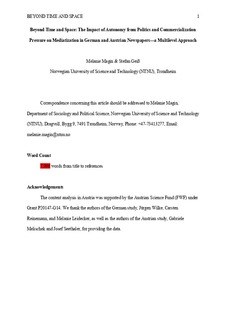Beyond Time and Space: The Impact of Autonomy from Politics and Commercialization Pressure on Mediatization in German and Austrian Newspapers—A Multilevel Approach
Journal article, Peer reviewed
Accepted version

View/
Date
2019Metadata
Show full item recordCollections
Abstract
Theorizing on mediatization of politics stresses the importance of structural conditions on different levels of media systems for explaining the increasing importance of media logic in media coverage. Levels of autonomy of media from politics and the extent of commercialization pressure are considered particularly important. However, most studies investigate differences between countries and the passing of time as proxies and qualitatively infer which structural conditions might account for the level of mediatization. The current study goes beyond these proxies. It reviews and systematizes how structural autonomy from political institutions and extent of commercialization pressure influences the importance of media logic in media coverage and operationalizes these influences in a comparative analysis of election campaign coverage in Germany and Austria over 60 years. A multi-level analysis finds that between-country differences and within-country changes in macro- and meso-level autonomy from politics/commercialization pressure account for a large part of the time/space (campaign/country) variation of the importance of media logic. It complements earlier research (1) by demonstrating that between-country differences and within-country changes in media coverage reflect underlying media structures; (2) by specifying which structural influences (representing the media’s autonomy from politics and commercialization pressure) are most important in shaping the importance of media logic in campaign coverage.